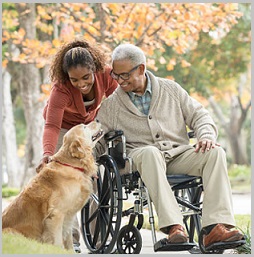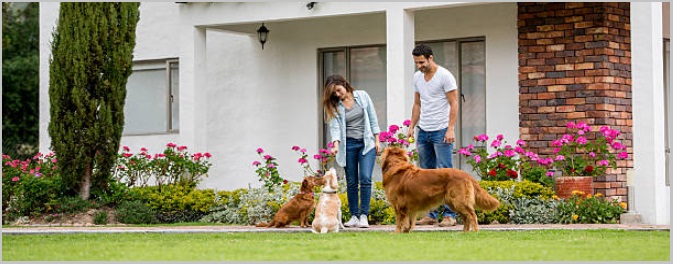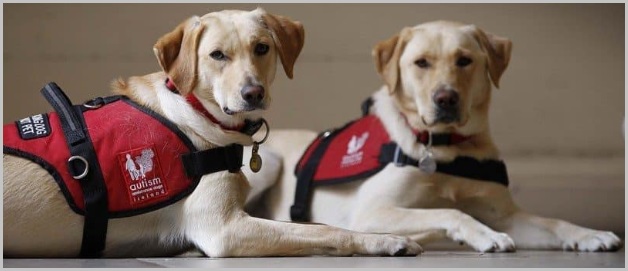Table Of Contents
 Golden Retriever As An Assistance Dog
Golden Retriever As An Assistance Dog
Specially trained assistance dogs help people with disabilities remain as independent as possible.
By helping with many everyday tasks, these wonderful dogs also give their partners a tremendous boost of self-confidence.
Who Needs These Special Dogs?

More than 55 million Americans are disabled in some way. A disability is basically anything that substantially limits one or more activities of daily living.
Disabilities can include blindness, cerebral palsy, epilepsy, hearing loss, multiple sclerosis, muscular dystrophy, Parkinson's disease, paralysis, seizures, or spinal cord injuries.
The law also covers people with psychiatric disabilities such as panic attacks, post-traumatic stress disorder (PTSD), manic depression and agoraphobia, to name a few.
What Can These Dogs Do?
Actually, there isn't much that these dogs can't do! Most people are familiar with guide dogs for the blind, but there are many other types of assistance a dog can provide.
Assistance dogs help their disabled owners with a wide range of tasks that most of us take for granted, such as:
- Open and close doors and drawers
- Retrieve cordless phones
- Turn lights on and off
- Help with dressing and undressing
- Carry items
- Retrieve dropped or needed items
- Pull a wheelchair if necessary
- Bring in mail and newspaper
- Help partner up after sitting or falling
- Help with climbing stairs
- Provide balance for walking
- Get a drink from refrigerator
- Bark for help on command
- Put laundry in and out of washer and dryer
- Assist in tidying house or yard--pick up, put away
- Fetch walker or wheelchair when out of reach
- Pull a drapery cord to open or close drapes
- Wake up partner for work or school
- Operate push button device to call 911
- Put paralyzed arm or leg back into place on wheelchair
- Assist wheelchair user to regain sitting position if slumped over
- Carry a note to another household member on command
- Find caregiver on command, lead back to location of disabled partner
- Wake up partner if smoke alarm goes off and assist to nearest exit
Benefits Beyond the Obvious
With all these tasks dogs can be trained to perform, an assistance dog can give disabled people complete mobility within their homes.
They also provide greater freedom and independence in public. Whether inside or out, these special dogs allow their partners to lead fuller lives.
Besides all the amazing things he can do, the dog's capacity for unconditional love is really the greatest gift of all. He provides constant companionship and emotional support. He offers the comfort and assurance of a friend who's always there to help.
Which Dog Breeds Make the Best Assistance Dogs?
Several different breeds are used for this special type of service dog, but the Golden Retriever and Labrador Retriever are the most popular and successful breeds.
That's because many of the tasks required of an assistance dog involve typical gun dog work--sniffing out an item that the owner wants and retrieving it. Most importantly, they tend to be soft mouthed with the items they work with.
Golden Retrievers are intelligent and eager to please, yet able to think on their own and work independently when necessary. They are willing and responsive, confident and personable. They are strong enough to support or pull a person. Their striking good looks are a nice bonus, too!
A good assistance dog is people oriented and not overly protective. He is confident without being either dominant or submissive.
Dogs are tested for friendliness, noise sensitivity, bonding ability, retrieving instincts and general trainability.
The dogs may come from a variety of sources, including animal shelters, humane society facilities, dog rescues and pounds, pet owners and breeders.
The selected dogs generally spend six months to a year at one of several assistance dog training schools located throughout the U.S. They receive training on tasks, obedience and public access manners. Each dog is also trained in tasks specifically tailored to the individuals they serve.
Because of everything that goes into the training and pairing of dogs and owners, the national average waiting time to receive an assistance dog is two to five years.
Capes and Permits
The special capes these dogs wear serve several purposes. First, they identify them as being service dogs so they're allowed public access. They're also handy backpacks to carry things such as a copy of the law and other important papers, along with doggy poo bags.
The owners are generally provided with permits that identify the dogs as licensed canine companions. That's enough to gain undisputed entry into most places, as with the more well-known guide dogs.
Opening The Door To a New Life
Assistance dogs greatly improve the quality of life for people with disabilities.
With a highly trained dog by his side, a disabled person can experience a new sense of joy and confidence at being able to interact and socialize freely.
It's even more life changing for disabled children. Suddenly, these children are no longer "that kid in the wheelchair." Now they're "that kid with the amazing dog."
Similar Articles :
1- Golden Retriever Lifespan .
2- Tramadol For Dogs : Dosage and Toxicity.
3- Can Dogs Eat Grapes Or Not?.
4- Golden Retriever Breed Standard.
5- Find Good Golden Retriever Forum.
6- How To Stop Your Dog From Biting .
7- My Dog Ate Chocolate What Should I Do? .
8- Golden Retriever Health Problems Issues.
9- How To Deal With An Golden Retriever Dog.
10- How To HOW TO STOP YOUR DOG FROM BITING.
11- Worming / Deworming Your Golden Retriever Puppies.
12- How To Deal With An Aggressive Golden Retriever Dog.
13-The Rabies Reality : Are Golden Retrievers Susceptible To Rabies
14- The Phases Of Rabies & Preventative Measures For Golden Retrievers
15- How To Remove A Tick From A Dog : Case Of Golden Retrievers
16- Golden Retriever Names
 Golden Retriever As An Assistance Dog
Golden Retriever As An Assistance Dog
Giveaway | ! Join Our Official Golden Retriever Giveaway – we are giving away Golden Retriever Puppies with new Galaxy S9 for product testing !
WOW Really good posting I must say and I am really glad to see your post..
Thanks as always for spreading nuanced quality content. I liked your info very much. It was very well-presented and approachable. Good job and looking forward to more articles.
Very useful article about assistance dogs, I really love your site web.I wanted to thank you for this great read!! hopefully in the future this article will be more better , I definitely enjoying each and every little bit of the article and I have you bookmarked your blog to check out new articles.
This is the first time I frequented your website dedicated to golden retriever dogs, and thus far? I amazed with the research you made to make this particular submit amazing. Wonderful task, Can I have your E-mail?
That was awesome, it was a great post by the way i love Golden retrievers.
Great post even I prefer the labrador breed.